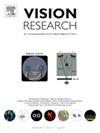即使在垂直方向的字母串中,日本读者的拥挤程度也有所下降
IF 1.4
4区 心理学
Q4 NEUROSCIENCES
引用次数: 0
摘要
视觉拥挤影响阅读表现。与此相关的是,字母阅读中的视觉拥挤效应比识别字符串中的符号要弱。先前的一项研究报告称,具有丰富水平文本阅读经验的参与者仅在水平字符串中观察到拥挤减少。在本研究中,我们研究了具有丰富阅读垂直和水平方向文本经验的日本读者在不同字符串方向上的字母识别性能。通过三个实验,我们观察到日语读者在垂直测试串中的拥挤减少。此外,当沿着不熟悉的方向(如对角线方向)读取字符串时,观察到的拥挤减少并不稳健。这些发现表明,特定文本方向的阅读体验自适应地塑造了字母特定检测单元的空间属性。然而,我们的研究结果也表明,阅读经验的影响有限。例如,拥挤减少对日文字母的影响不如对字母的那么强,这表明阅读经验对拥挤减少的影响取决于字母类型,而之前阅读的字母类型无关紧要。此外,当字符串与发生更强拥挤的区域对齐时,无论字母类型如何,拥挤减少并不稳健,即使对于字母也是如此。这些结果表明,阅读体验只会影响字母识别的特定部分,这可能对更高层次的字母识别很重要。本文章由计算机程序翻译,如有差异,请以英文原文为准。
Japanese readers show a crowding reduction even in vertically oriented strings of letters
Visual crowding affects reading performances. Related to this, the visual crowding effect is weaker in letter reading than in recognizing symbols in a string. A previous study reported that crowding reduction was observed exclusively in horizontal strings by participants with extensive reading experience in horizontal text strings. In the present study, we examined letter identification performance across various string orientations among Japanese readers with extensive experience reading both vertically and horizontally oriented texts. Through three experiments, we observed crowding reduction among Japanese readers in vertical test strings. Additionally, the observed crowding reduction was not robust when reading strings along unfamiliar orientations, such as diagonal orientations. These findings suggest that reading experience with specific text orientations adaptively shapes the spatial properties of letter-specific detection units. However, our results also indicate that reading experience has limited influence. For example, crowding reduction was not as robust for Japanese letters as it was for alphabet letters, showing that the influence of reading experience on crowding reduction depends on letter type, whereas letter type in previous reading does not matter. Furthermore, when the strings aligned with the zone where stronger crowding occurs, irrespective of letter type, crowding reduction was not robust, even for alphabet. These results imply that the reading experience could affect only a specific part of letter identification, which is likely important for alphabet identification in higher-level processing.
求助全文
通过发布文献求助,成功后即可免费获取论文全文。
去求助
来源期刊

Vision Research
医学-神经科学
CiteScore
3.70
自引率
16.70%
发文量
111
审稿时长
66 days
期刊介绍:
Vision Research is a journal devoted to the functional aspects of human, vertebrate and invertebrate vision and publishes experimental and observational studies, reviews, and theoretical and computational analyses. Vision Research also publishes clinical studies relevant to normal visual function and basic research relevant to visual dysfunction or its clinical investigation. Functional aspects of vision is interpreted broadly, ranging from molecular and cellular function to perception and behavior. Detailed descriptions are encouraged but enough introductory background should be included for non-specialists. Theoretical and computational papers should give a sense of order to the facts or point to new verifiable observations. Papers dealing with questions in the history of vision science should stress the development of ideas in the field.
 求助内容:
求助内容: 应助结果提醒方式:
应助结果提醒方式:


